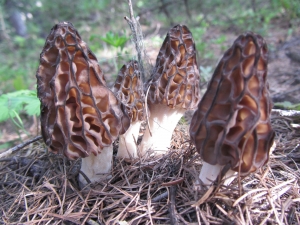 Morchella elata, M.angusticeps, M.conica
Morchella elata, M.angusticeps, M.conica
Once picked and tasted, Morels are forever longed for. Morels are one of the most sought after fungi for the kitchen. Known for its complex honeycombed cap and hollow inside they are hard to miss. If you can find them to begin with. Good for soups and sauces, they are great for stuffing also. Ingredients such as garlic and herbs go well with morels ,while caraway and sweet peppers enhance their earthy flavor. The morel mushroom, no matter the variety, should always be cooked.
There are 5 varieties of morels. First the half-free or early morel-(Verpa bohemical, V. conica) It is usually the first morel of the spring, but is the least desired morel. It has only a bit of cap and the rest is stem, which can be on the chewy side. The flavor of this morel is not as good as the true morels and if eaten often and in large amounts it can be poisonous. But they represent the beginning of the season with the promise of more morels.
The black morel-(Morchella angusticeps, M. elata(fat headed morel) M. conica)(narrow headed black morel). These morels are usually the next to appear, if not along with the half-frees. You are most likely to find this morel at a logged area or burn site. They are the toughest morel to see in the forest due to their darker coloring.
Yellow Morel, tan morel, (Morchella esculenta, M.crassipes) (club foot morel) a larger version. A morel lovers favorite. The yellow morel can grow quite large. Because of its color and size it is easier to spot in the forest than the black morel. It tends to grow in a wider habitat then the black morel also.
White morel-(Morchella deliciosa) This is a smaller morel. But its size does not dampen its flavor. Its habitat is similar to that of the yellow morel and can be found growing right alongside it.
False morel-(Gyromitra species)These morels are considered poisonous and best left alone. They stand tall and erect like other morel species but have a smooshed, deformed look to their cap and the stems are solid instead of hollow.